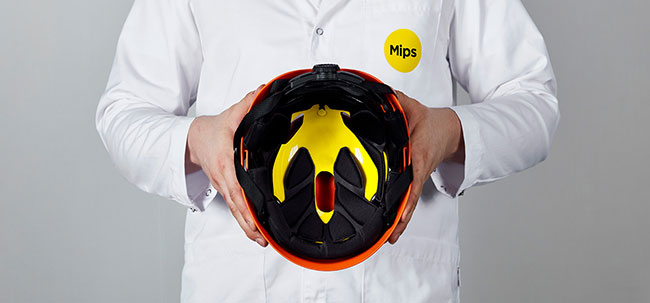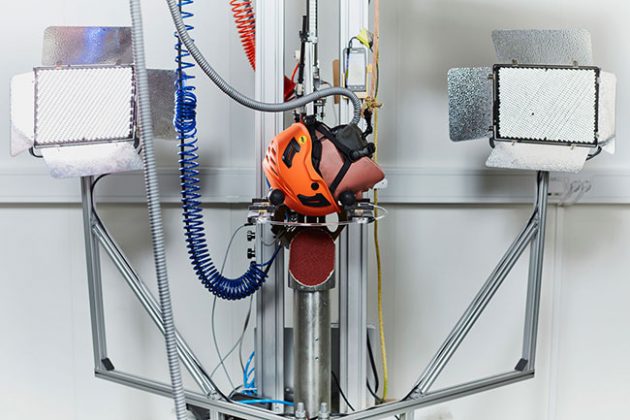
Features
Contracting
Innovations
Keeping your head – No-twist helmets offer an additional level of worker safety
Why aren’t construction workers wearing safer helmets?
March 3, 2021 By Peter Halldin
 The MIPS brain protection system is designed to add protection against rotational motion transferred to the brain. Photo Credit: MIPS
The MIPS brain protection system is designed to add protection against rotational motion transferred to the brain. Photo Credit: MIPS
Construction can be a dangerous industry. Across North America, construction professionals – whether ironworkers, sandhogs, electricians or plumbers – build the tallest buildings, the longest highways and the most awe-inspiring infrastructure that has forever been the foundation of moving a national economy forward. They do so knowing the risks inherent in achieving big things – and knowing that things can sometimes take a bad turn, with one in every 10 construction workers being injured every year and companies bearing the financial brunt of those injuries in both workers’ compensation costs and lost time on jobs.
When jobsite incidents occur, it’s a worker’s safety equipment that can often mean the difference between going home, going to the hospital or going to the morgue.
Safety helmets are the most ubiquitous piece of equipment found on any job site. They are the extension of a worker’s personality, often meticulously decorated with stickers from past jobs, union affiliations or favorite bands and beverages.
But many of those helmets are missing something: a piece of technology that can reduce the risk of a traumatic brain injury.
Construction companies outside the U.S. utilize MIPS technology (Multi-directional Impact Protection System) inside the helmet, which is an insert that reduces the risk for rotational motion injuries. When something falls from height or impacts from the side and strikes a worker on a job site, it never hits straight on. There is almost always an angled force that comes to bear, rotating the head inside the helmet and causing trauma to the brain. MIPS technology allows the helmet to rotate, reducing the rotational motion that may cause stress on the brain.
The MIPS brain protection system is designed to add protection against rotational motion transferred to the brain. Rotational motion affects the brain and increases the risk for minor and severe brain injuries. When implemented in a helmet, MIPS can reduce rotational motion by redirecting energies and forces otherwise transferred to the brain.
The core of MIPS is a low-friction layer that allows the head to move 10-15 millimetres relative to the helmet in all directions, reducing rotational motion to the brain. MIPS makes the helmet safer and adds protection.

The dummy head, wearing a helmet, was subjected to an angled impact in a test rig at the MIPS lab in Sweden.
Rotational motion from an angled impact can cause strain in the brain that can lead to tearing in the brain tissue. This information is based on data gathered using sensors inside crash test dummy heads. The dummy head, wearing a helmet, was subjected to an angled impact in a test rig at the MIPS lab in Sweden. The test showed the strain in the brain from an angled impact when the dummy head was wearing the same type of helmet, with and without MIPS.
Statistics show that many brain injuries occur due to angled impacts to the head. However, in standard helmet tests the helmet is dropped vertically onto a flat surface and this does not create an angled impact. These results are helpful for measuring precise vertical impacts, but inferior for measuring a more realistic scenario of an angled impact.
The MIPS test rig is developed for testing angled impacts to simulate a fall during a crash. Depending on what type of helmet is tested, the helmet is dropped from 2.2 to 3.1 metres onto a 45-degree impact angle covered with grinding paper. Three different types of impact points are tested and all helmets are tested in all sizes.
Data is gathered using nine accelerometers inside a Hybrid III crash test dummy head and analyzed using finite element models. The same helmet model is compared with and without MIPS to make sure the helmet passes the strain reduction criteria MIPS have on all approved helmets.
More than 27,000 tests have been conducted at the global test centre in Stockholm, Sweden. In addition to that, a number of third-party tests have also been made supporting MIPS safety claims.
Many sport helmet brands offer bicycle, ski, hockey, motorcycle, and other helmets with MIPS technology. Yet a survey shows that most North American construction helmets lack the inclusion of MIPS technology. Construction workers deserve the same protection.
In an industry where safety is universally touted as “a top priority” or “job number one,” we think putting safer technology into the hands – and on the heads – of every North American construction worker is an absolute necessity. •
Peter Halldin is CSO and co-founder of MIPS, and a researcher at the Swedish Royal Institute of Technology. Together with Hans von Holst, a Swedish neurosurgeon, they founded MIPS, a brain protection system – engineered to add protection to helmets.
Print this page
Leave a Reply